On test: Five top-spec electric chainsaws compared
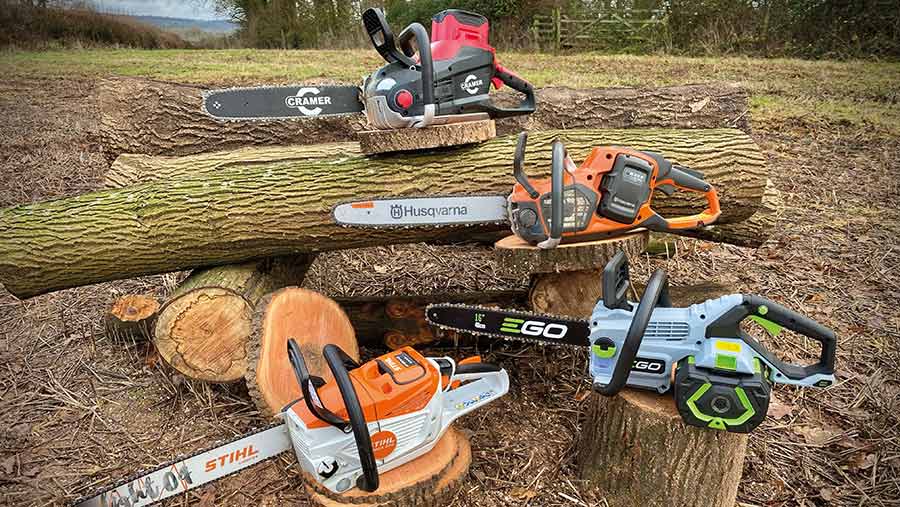 © MAG/Oliver Mark
© MAG/Oliver Mark They might sound more like an electric carving knife than a serious piece of timber-felling equipment, but don’t be fooled… battery powered chainsaws mean business.
In fact, such has been the improvement in performance over recent years that the gutsiest models promise power and chain speeds to rival 50cc petrol saws – a common size found on farms.
Added to that, advances in battery technology mean operators should be able to get decent run times to a charge.
See also: Top tips for chainsaw chain and guide bar maintenance
Benefits over their screaming two-stroke cousins include quieter running, significantly lower maintenance, and no more tedious fuel mixing. It sounds tempting, but can they really be that good?
To find out, we assembled five of the latest top-spec models and pitted them against Stihl’s MS261 C-M petrol – a popular pro-spec 50cc saw that can be fitted with guide bars from 14-18in.
Our contenders came in the form of Stihl’s new MSA300 (the cordless equivalent of the MS261), Husqvarna’s 540iXP, the 40V MAX XGT from Makita, Ego’s Power Plus CS1610E and the 82CS34 from Swedish brand Cramer.
All have sufficient firepower to run a 40cm (16in) guide bar – our choice for this test – and they’re IPX4 rated so they can be used in all weathers.
To assess how much cutting time each offers, we asked manufacturers to send their largest slot-in battery packs.
We steered away from bulky backpack units as these are expensive and mainly aimed at professional landscaping firms and tree surgeons that use their tools day-in, day-out.
How we tested them
After assembling a pile of uniform timber, we subjected each saw to a series of power and running time tests.
These included timed down/up cookie cuts (taking thin discs of timber) in a 30cm-diameter ash trunk, before timing how much cutting we could get out of a battery pack.
This wasn’t scientific but gives a rough idea of how much work you can get out of one of these saws when pushing it hard.
We also timed the batteries charging, to show how long you need to twiddle your thumbs before getting back to work.
A note about prices
Rather than publish retail prices, we’ve hunted down the best online deals we could find from reputable firms at the time of writing, excluding VAT.
Prices from dealers might be slightly higher, but you’ll be getting a more personal service for your money.
Some of the saws featured here can be purchased in a kit with batteries and charger included, which is often a cheaper approach than buying individual components.
The benchmark – Stihl MS261 C-M
Test results
- Cutting speed in 30cm-diameter timber 20sec
Specs and prices
- Engine Stihl 2-Mix 50.2cc
- Bar 40cm (16in) Stihl Light 04
- Chain Stihl RS Pro
- Chain gauge/pitch 1.3mm/8.25mm (0.325in)
- Max chain speed 28m/sec
- Weight with full oil and fuel tanks 6.9kg
- Online price £608
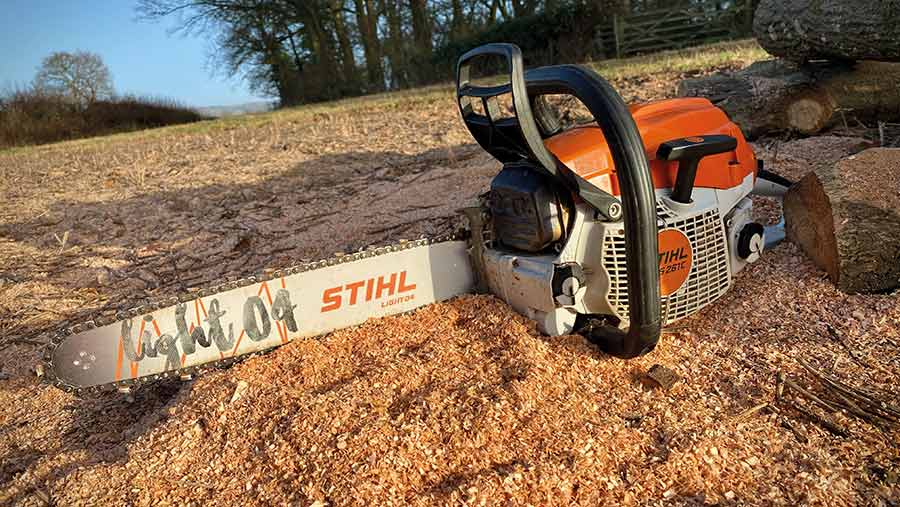
© MAG/Oliver Mark
Stihl MSA300
Best for: Cutting speed and run time
Launched last year, the MSA300 is the first cordless chainsaw from Stihl aimed at professional users, meaning it has the same Light 04 guide bar as its petrol equivalent and slightly outguns it on chain speed.
It is compatible with Stihl’s range of AP batteries, so buyers who already own some of these can get it up and running.
However, unleashing the top chain speed requires one of the latest AP500S packs with laminated cells.
These offer a higher energy density and longer lifespan of 2,400 charging cycles – about 10 years if you charge it once for every working day of the year.
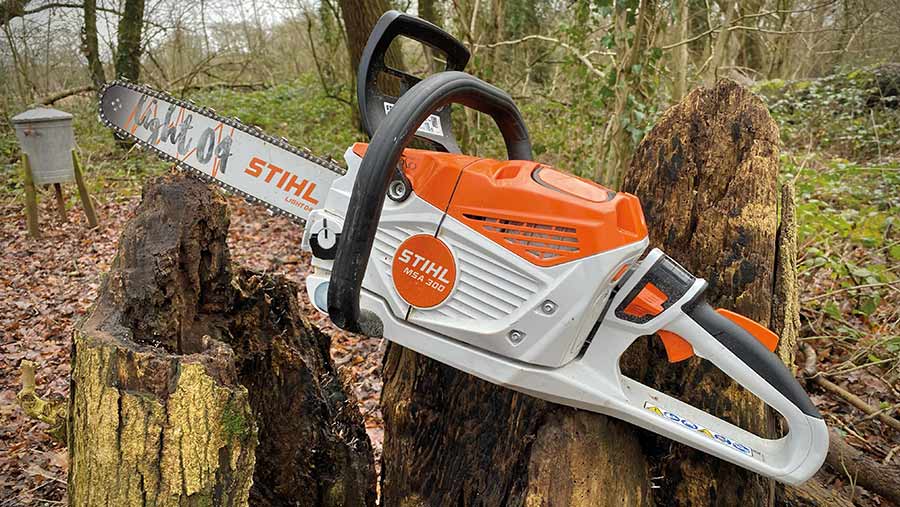
© MAG/Oliver Mark
True to its claim, this saw gave blistering performance in the highest of its three chain speeds and was the only model to outpace our petrol benchmark.
You don’t get something for nothing though, and we only managed 22 cuts on the fastest 30m/sec setting before the battery was drained.
Dropping down to the mid 24m/sec setting gave far better run time, with only a marginally slower cutting speed.
We also tried out the slower 20m/sec “eco” mode, which is fine for light work such as snedding (stripping off small branches), but lacked the power to comfortably perform larger cuts.
We used the saw in the 24m/sec setting most of the time and it was a good match for the petrol MS261.
However, its 1kg weight penalty was noticeable and, even though the battery life was good, we’d have needed a pile of them to keep pace over a sustained period.
The batteries also got hot when we were pushing the saw on, so we needed to wait for them to cool before they could be recharged.
When we did slot them on the charger, they were some of the fastest to replenish.
Likes and gripes
✔ Fast cuts
✔ Strong battery life on medium power
✔ Compact battery pack
✘ Heavier than petrol equivalent
✘ Loud on fastest setting
✘ Top chain speed eats batteries
Test results
- Cutting speed19sec on 30m/sec setting; 21sec on 24m/sec setting
- Number of cuts to a charge 22 full power; 66 medium power
- Battery charging time 48min
Specs and prices
- Bar 40cm (16in) Stihl Light 04
- Chain Stihl RS Pro
- Chain gauge/pitch 1.3mm/8.25mm (.325in)
- Max chain speed 30m/sec
- Battery pack Stihl AP500S 36V, 8.8Ah
- Charger AL500
- Weight with battery 7.9kg
- Online bare tool price £565.83
- Online battery pack price £265.83
- Online charger price £95.83
- Total £927.49
Ego Power Plus CS1610E
Best for: Run time on a lower budget
Ego is a relatively new name in the cordless tool world, but it has been expanding rapidly and has a ruck of domestic-grade equipment on offer, as well as a growing presence in the professional sector.
The CS1610E is the top saw in the consumer-level Power Plus range, with a chain speed of 20m/sec and a 40cm bar.
The firm also offers a more expensive pro-spec version with a few extra features and slightly longer guide bar, but the chain speed is the same.
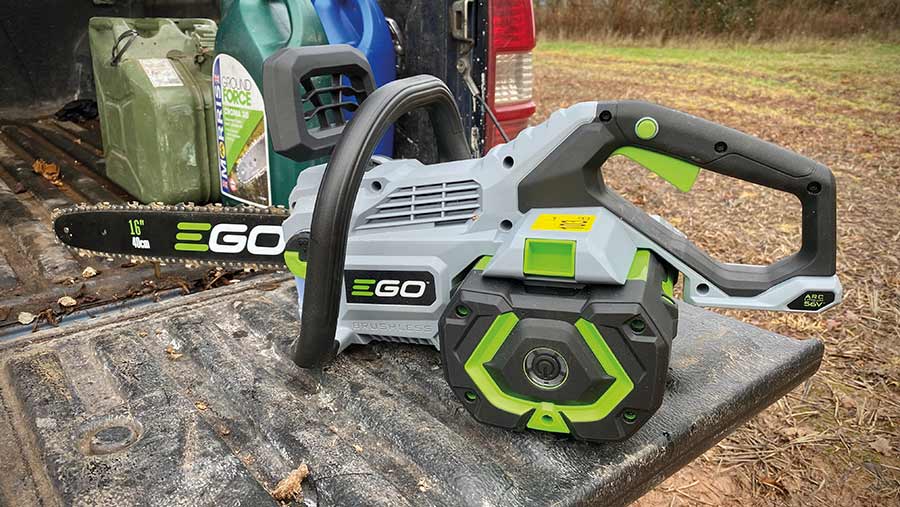
© MAG/Oliver Mark
Our test saw came with one of the largest 56V slot-in battery packs, with a capacity of 7.5Ah. This uses Ego’s arc cell-packaging technique, which is designed to prevent the battery overheating when it’s worked hard.
As you’d expect, the saw had a more hobbyist feel than the most expensive models in our test, with a plastic tool-free sprocket cover and chain tensioner.
However, the build quality was good, and we reckon it would be a fine choice for the occasional user who doesn’t plan on giving it too much abuse.
Unsurprisingly, having the slowest chain speed in the test meant the Ego took the longest to perform a cut.
But it rarely bogged down and it gave the second-longest run time to the Stihl. The battery indicator light wasn’t the most consistent, though, with the lights jumping around between cuts.
The saw itself can be picked up relatively cheaply, but the battery is expensive and quite bulky.
Likes and gripes
✔ Reasonable price
✔ Easy to use
✔ Decent run time
✘ Bulky battery
✘ Slow cutting
✘ Vague battery life indicator
Test results
- Cutting speed 38sec
- Number of cuts to a charge 47
- Battery charging time 59min
Specs and prices
- Bar Oregon 40cm (16in)
- Chain Oregon Micro-Lite Narrow-Kerf cutting system
- Chain gauge/pitch 1.1mm/9.5mm
- Max chain speed 20 m/sec
- Battery pack ARC lithium 56V, 7.5Ah
- Charger ARC lithium 56V rapid charger
- Weight with battery 7.1kg
- Online bare tool price £174.16
- Online battery pack price £265.83
- Online charger price £65.83
- Total price £505.82
Cramer 82CS34
Best for: Power on a lower budget
Cramer is a new player in the cordless power tool market, sweeping in with a range of high-powered equipment running on punchy 82V battery packs.
The brand is based in Sweden, but is owned by Chinese outfit Globe Group, which already has a consumer range of Greenworks products.
There are plenty of similarities between the offerings from these two brands, but the Cramer kit is built for professional operators.
Occupying the top slot in the chainsaw range is the 82CS34, which comes with a powerful brushless motor and 38cm (15in) bar that can run at a speedy 25m/sec.
On paper, this put it second only to Stihl’s MSA300, which translated neatly to the second-fastest cutting times in our tests – about the same as the Stihl on its mid-chain speed and just a shade slower than the petrol benchmark.
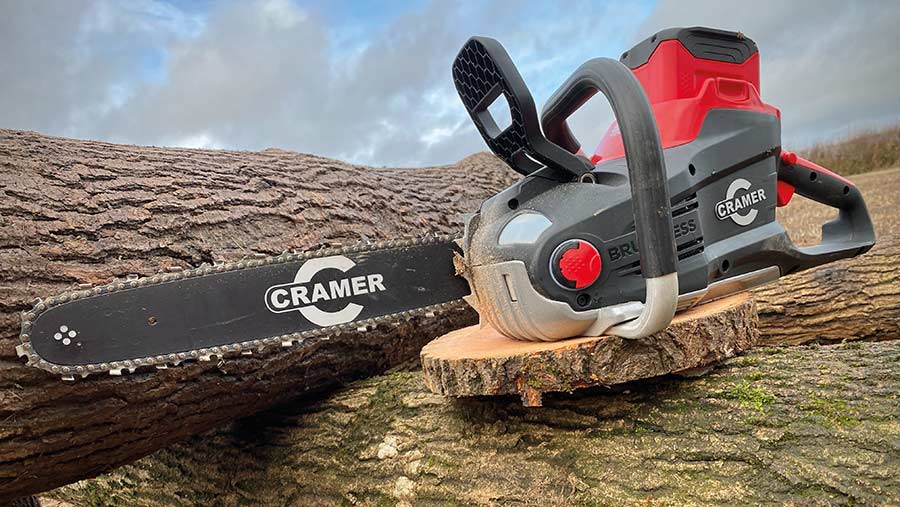
© MAG/Oliver Mark
Its huge brick-like powerpack also gave it run times to rival some far less powerful saws, meaning we could get decent output from it.
And we liked the clear battery life indicator that shows the remaining charge as a percentage.
The downside is that the bulky battery sticks out well above the top of the saw, making it an ungainly beast to swing around, and it was the heaviest in the test by some margin.
While we’re picking things out, it didn’t run quite as smoothly as the Stihl or Husqvarna either.
For those who want decent power and run time without having to shell out top dollar for a Stihl, it seems to be a reasonable contender.
Likes and gripes
✔ Powerful
✔ Decent battery life
✔ Tough construction
✘ Heavy
✘ Bulky battery that sticks out of saw
✘ Not as smooth as some
Test results
- Cutting speed 21sec
- Number of cuts to a charge 40
- Battery charging time 1hr 21min
Specs and prices
- Bar Oregon 38cm (15in)
- Chain Oregon Speedcut
- Chain gauge/pitch 1.3mm/8.25mm (.325in)
- Max chain speed 25 m/sec
- Battery pack 82V360 lithium 82V, 5Ah
- Charger 82C2 82V Lithium Max
- Weight with battery 8.9kg
- Online tool price £318.17
- Online battery pack price £227.26
- Online charger price £83.33
- Total £628.76
Husqvarna 540iXP
Best for: Lightness and handling
Husqvarna and Stihl are the two stalwarts of the chainsaw game, locked in a never-ending battle to develop the best products.
In terms of power, Stihl currently has the upper hand, but Husqvarna’s top-spec 540iXP stands out for its lightness and easy handling.
At just 5.9kg with a 9.4Ah battery fitted, the saw was comfortable to use for long periods and, because it wasn’t overly powerful, offered a reasonable amount of cutting time to a charge.
The neat horizontal battery port also meant it was the only one that didn’t collect sawdust.
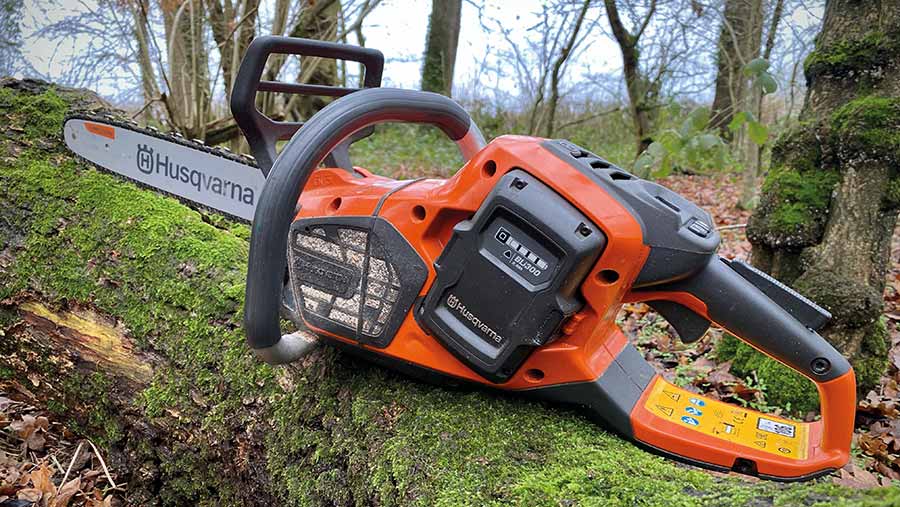
© MAG/Oliver Mark
When working in smaller timber, the fast 24m/sec chain speed gave decent cutting ability, but if we pushed it too hard in large-diameter hardwood it could get bogged down.
For this reason, it’s probably best reserved for lighter duties with a 14in bar installed, which would make it even lighter and easier to handle.
At full tilt, the motor is quite loud, but this isn’t a problem for those who are being good and wearing their ear defenders.
The palm safety catch also takes some getting used to, as it requires a bit of forward movement of the hand to get it to release.
Since we carried out the test, the 540iXP has received an update that now sees it come with a heated handle and a digital oil-level indicator.
Likes and gripes
✔ Lightweight and easy to handle
✔ Compact battery that fits within saw
✔ Decent run time
✘ Not that powerful
✘ Cuts out if pushed hard
✘ Awkward palm safety switch
Test results
- Cutting speed 38sec
- Number of cuts to a charge 40
- Battery charging time 1hr 18min
Specs and prices
- Bar Husqvarna 40cm (16in)
- Chain Husqvarna X-Cut SP21G
- Chain gauge/pitch 1.1mm/8.25mm (.325in)
- Max chain speed 24m/sec
- Battery pack BLi300 36V, 9.4Ah
- Charger QC330
- Weight with battery 5.9kg
- Online bare tool price £450
- Online battery pack price £257.50
- Online charger price £89.99
- Total price £797.49
Makita 40V Max XGT
Best for: Value for money
For years, Makita ran all its tools off 18V battery packs, coming up with a clever ruse to run the gutsiest models with two batteries wired together in series to give a 36V output.
These tools still exist but, to harness some additional firepower, the firm has introduced a separate 40V Max XGT system that runs alongside.
One of the tools benefiting from this power source is the UC016GT201 chainsaw. Like the saws from Ego and Cramer, it comes with a 40cm (16in) bar and chain from Oregon that spins at a respectable 25.5m/sec.
This gave it the third-fastest cutting time, beating both the Husqvarna and Ego.
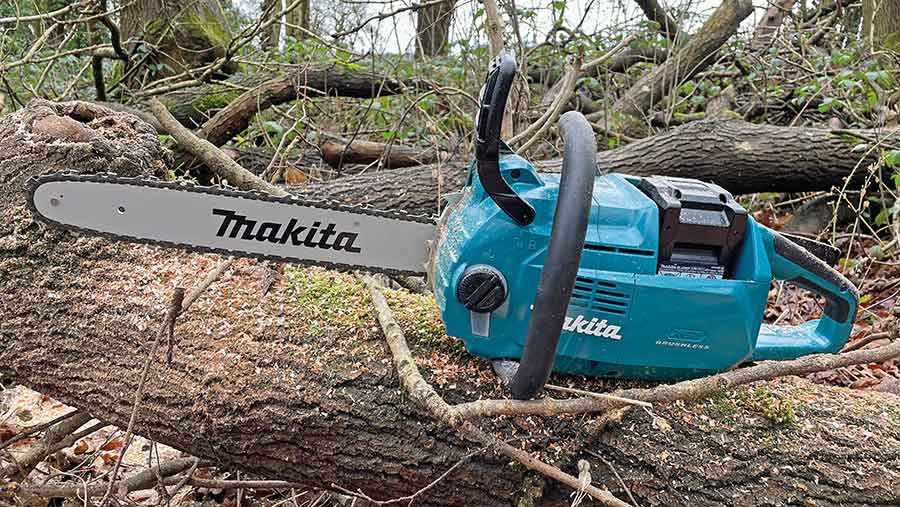
© James Andrews
Its 5Ah battery pack didn’t have the staying power, though, and, apart from the Stihl on its fastest speed setting, it was the first to run out of juice.
However, it did redeem itself with the fastest recharging time.
Other good points were its light weight and good balance that made it an easy saw to handle.
It is also sensibly priced, making it a handy option to run alongside a petrol model for smaller jobs.
Build quality was decent, but it had a more domestic feel than its more expensive rivals.
We also weren’t overly enamoured by the tool-free sprocket cover and rotary chain tensioner, both of which we found awkward to use. Plus, the large battery slot tended to fill up with sawdust.
Likes and gripes
✔ Reasonable price
✔ Compact battery packs
✔ Nicely balanced
✘ Fiddly sprocket cover and chain tensioner
✘ Short battery life
✘ Battery slot fills with sawdust
Test results
- Cutting speed 32sec
- Number of cuts to a charge 28
- Battery charging time 43min
Specs and prices
- Bar 40cm
- Chain Oregon SpeedCut Nano
- Chain gauge/pitch 1.1mm (0.043in)/8.25mm (0.325in)
- Max chain speed 25.5m/sec
- Battery pack BL4050 XGT Max Li-ion 36V, 5Ah
- Charger DC40RA fast charger
- Weight with battery 6.9kg
- Bare tool price £243.33
- Battery pack price £163.29
- Charger price £60.79
- Total £467.41
Battery v petrol verdict
Our quest was to find out if the latest battery-powered saws could match the performance of a petrol and, thanks to Stihl’s MSA300 and Cramer’s 82CS34, it’s clear they can.
But, before we all run off to list our two-stroke saws on eBay, it’s wise to consider the full picture.
Let’s start with the good bits. Cordless saws are far quieter than a two-stroke, require less maintenance, cut quickly and can now return reasonable run times to a charge.
We enjoyed the little prep required before we could go sawing, and after getting used to the quiet running it was a bit of an assault on the senses going back to the rasp of a two-stroke.
But they are heavier than their octane equivalents, upfront costs are much higher, and they require several expensive batteries, or a bulky backpack unit for continuous operation.
As a result, we reckon cordless saws are still best suited to smaller jobs that don’t require sustained cuts in large-diameter timber.
But for day-long sawing epics away from a mains electricity supply, petrol is still top dog… at least for now, anyway.

